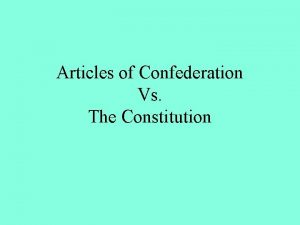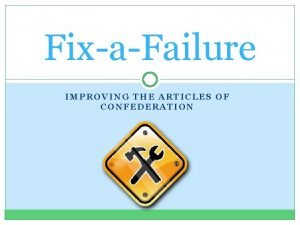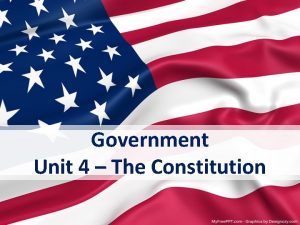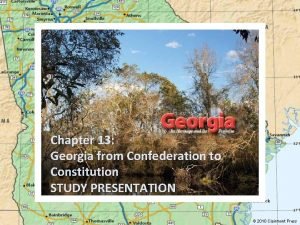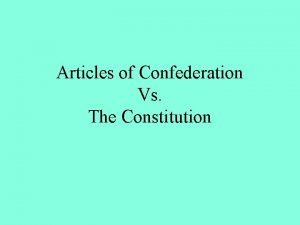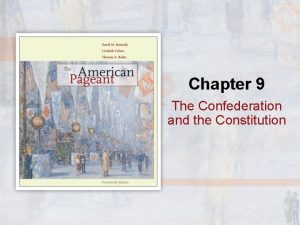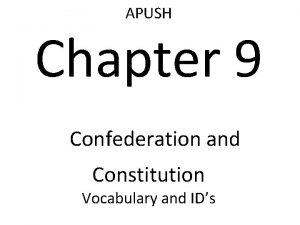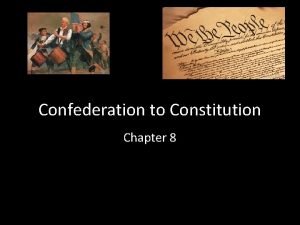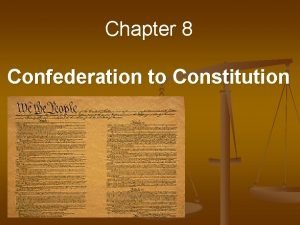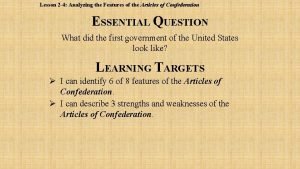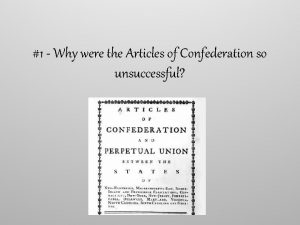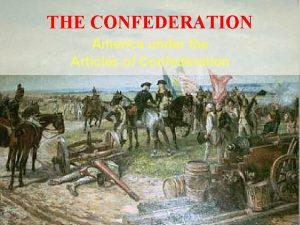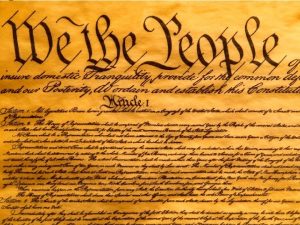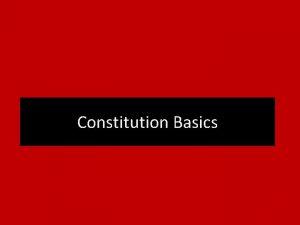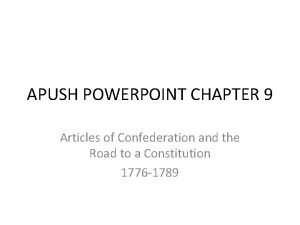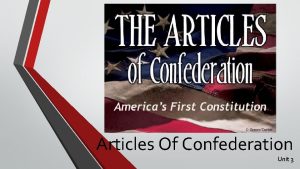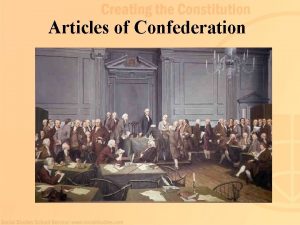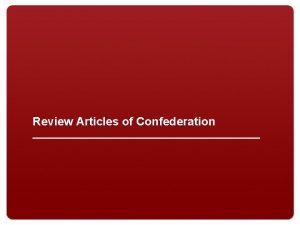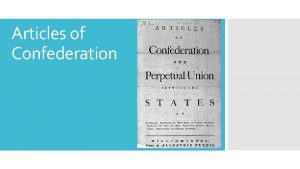Government The US Constitution Articles of Confederation WalkAround


















- Slides: 18

Government: The US Constitution

Articles of Confederation Walk-Around EPIC FAIL • Bring your whiteboard and marker. • Read as many cards as you can before time is up. • For each card, try to write what it’s talking about. • ULTIMATE DECISION: • How did people feel about the Articles of Confederation? • What were the main complaints? • Done? Find you seat and make a final list of complaints using what you’ve learned from the cards. Add, erase, and/or reorganize.

Articles of Confederation: EPIC FAIL • Weak national gov’t • Couldn’t tax = no $ • Couldn’t set up trade • Each state had own $ 10 arm circles • No executive branch = No main leader • No one to represent US to other countries • No way to hold Britain to the treaty agreements • No army (Shay’s rebellion barely stopped) 10 jumping jacks • No judicial branch = no one to decide disputes • Each state = 1 vote for laws (no matter its size) • Hard to pass laws (9/13) • Hard to change (13/13) Plank 20 sec

Constitutional Convention • Throw out the Articles of Confed. and start over! • 55 delegates (representatives) from 12 states • Summer 1787 Philadelphia, PA 10 jumping jacks • VIP’s: • • George Washington (Prez of Convention) James Madison- “Father of Constitution”; took notes; came with a plan (VA) Ben Franklin- Cooperate! Gouvernor Morris- wrote final draft • Lots of arguing and compromise • US Constitution = “Supreme Law of the Land” 10 lunges

Preamble: Intro to the Constitution • We the people of the United States, in order to form a more perfect union, • establish justice, • ensure domestic tranquility, • provide for the common defense, • promote the general welfare, and • secure the blessings of liberty • to ourselves, and our posterity, • do ordain and establish this Constitution for the United States of America

YOU Decide: Legislative branch 1. Identify the problems. • Have both sides explain what they want to happen. • Talk about the differences between the two sides’ wants. • Boil it down to a main problem that you can solve. 2. Think of possible solutions. Consider possible compromises. 3. Make a plan with the best solution/compromise. Explain how it would work exactly. 4. Think about obstacles this new plan may face.

Article 1: Legislative Branch • 2 Houses of Congress • Senate: each state gets 2 senators (100; 6 yrs. ) • House of Representatives: population decides number each state gets (435; 2 yrs. ) 10 arm circles • Propose, Make, and Pass Laws • • A Bill (idea for a law) Majority vote in each House Prez to sign or veto Law Veto 2/3 of both Houses of Congress to overrule Law Approves Prez’s Cabinet (key jobs) Approve Prez’s picks for Judges Declare War and Approve Treaties Remove (Impeach) Prez, Judges, etc. Tax and Create $$$ Amend (change) the Constitution ( + or - ) 10 Squats

Article 2: Executive Branch • 2 • P

Article 3: Judicial Branch • Interpret the Laws • Constitutional or Unconstitutional = fair or unfair • Settle disputes between states & with government Your choice stretch • Supreme Court • highest court in the country (final say) • Justices = Judges (9) • Serve for life; Prez chooses 10 Squats

Mock Government • Legislative: • Phase one: Come up with an idea for a new law; then, vote on it • Phase two: Consider the Prez’s idea for a new law; vote on it • Phase three: Re-vote on your law if it’s vetoed by the president OR rewrite your law if it was declared unfair • Executive: • Phase one: Come up with an idea for a new law; then present it to Congress • Phase two: Decide to sign or veto Congress’s law; pass on to Judicial • Phase three: Sign or veto Congress’s other laws • Judicial: • Phase one: Rule on the fairness of the current laws • Phase two: Write up explanation of any unfair laws & present to Congress • Phase three: Rule on the fairness of the new law

YOU Decide: What about slavery? 1. Identify the problems. • Have both sides explain what they want to happen. • Talk about the differences between the two sides’ wants. • Boil it down to a main problem that you can solve. 2. Think of possible solutions. Consider possible compromises. 3. Make a plan with the best solution/compromise. Explain how it would work exactly. 4. Think about obstacles this new plan may face.

Article 1: Legislative Branch • 2 Houses of Congress • Senate: each state gets 2 senators (100; 6 yrs. ) • House of Representatives: population decides number each state gets (435; 2 yrs. ) Three-Fifths Compromise Each slave counted as 3/5 of a person toward the population. • Propose, Make, and Pass Laws • • A Bill (idea for a law) Majority vote in each House Prez to sign or veto Law Veto 2/3 of both Houses of Congress to overrule Law Approves Prez’s Cabinet (key jobs) Approve Prez’s picks for Judges Declare War and Approve Treaties Remove (Impeach) Prez, Judges, etc. Tax and Create $$$ Amend (change) the Constitution ( + or - )

Article 5: Amendments (Bill of Rights) • Many wouldn’t sign without a list of rights • First 10 amendments (changes) of the Constitution 1. Freedom of Speech, Press, Religion, and Assembly/Petition 2. Bear Arms (guns) 3. No quartering soldiers 4. No unreasonable search & seizure 5. Due Process, Can’t witness against self, No Double Jeopardy 6. Right to speedy trial, by jury, lawyer 7. Jury 8. No cruel & unusual punishment 9. There are other rights not listed here; Your rights can’t be used against others. 10. Rights/Responsibilities not given to federal government belong to the states

Group Roles • Writer- responsible for helping with every step AND writing summary • Judge- responsible for helping with every step AND has final say of what gets written down; (remember, R-P-S solves a lot of conflict!) • Tech Operator- responsible for helping with every step AND is the one who physically touches the computer to complete those steps. • Recorder- responsible for helping with every step AND is the one who records their voice reading the summary into the computer. This person may touch the computer while recording.

Create a Bill of Rights“Chatterpix” 1. Review notes and the book section to find important details. 2. Write a short summary (30 seconds) of the right you were given. • Why we felt we needed it (like what caused us to want it- think Rev. War events) • What exactly it gives us or protects • What life would be like without it/why it’s important for us to have 3. Raise your hand to get your summary checked before moving on! 4. Choose an appropriate picture that represents your event. www. safesearchkids. com (Choose “safe images”, then search for your right/pic that represents it well) 5. Go to new picture talking website: http: //www. abcya. com/talkify. htm 6. Choose “upload own picture” and access the pic you saved. 7. Follow directions on site. Record your voice reading the summary. 8. When finished, click to download (down arrow twice). 9. Then, name it with your homeroom teacher and all first names of group members. 10. Then, click the “Drive” over on the left to save it in my Drive. Choose the “Bill of Rights Chatterpix” folder, and then your homeroom folder.

Article 6 and 7: Law of Land & Ratification • Explains how to ratify/approve • Approved in 1790 by all 13 Colonies • Some only signed when a Bill of Rights was promised

Responsibilities of Citizens • Obey laws • Vote (18) & Be Informed • Serve on Jury 10 jumping jacks • Pay Taxes • Protect rights of others • Let others exercise their rights • Don’t use your freedoms or beliefs to harm others • Take Responsibility, Show Respect, and Be a Good Tree Pose 30 sec Citizen!

P-E-D A. Explain two specific rights that the Bill of Rights guarantees us. Explain how it was and is important to US citizens. B. Explain 2 reasons the Constitutional Convention decided to write a new Constitution instead of fixing the Articles of Confederation.
 Constitution vs articles of confederation
Constitution vs articles of confederation Problems with the articles of confederation
Problems with the articles of confederation Articles of confederation vs constitution
Articles of confederation vs constitution Articles of confederation apush
Articles of confederation apush Articles of confederation vs constitution
Articles of confederation vs constitution Articles of confederation vs constitution chart
Articles of confederation vs constitution chart Chapter 9 the confederation and the constitution
Chapter 9 the confederation and the constitution Chapter 9 confederation and constitution
Chapter 9 confederation and constitution Chapter 8 confederation to constitution
Chapter 8 confederation to constitution Chapter 8 confederation to constitution
Chapter 8 confederation to constitution Strengths of the articles of confederation
Strengths of the articles of confederation Why were the articles of confederation unsuccessful
Why were the articles of confederation unsuccessful Articles of confederation
Articles of confederation Articles of confederation strengths
Articles of confederation strengths Articles of confederation main idea
Articles of confederation main idea Weaknesses of the articles of confederation
Weaknesses of the articles of confederation Weakness and strengths of the articles of confederation
Weakness and strengths of the articles of confederation Articles of confederation mnemonic
Articles of confederation mnemonic Conventions to ratify constitutions apush
Conventions to ratify constitutions apush
